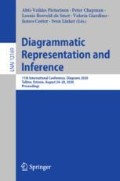Abstract
Choosing effective representations for a problem and for the person solving it has benefits, including the ability or inability to solve it. We previously devised a novel framework consisting of a language to describe representations and computational methods to analyse them in terms of their formal and cognitive properties. In this paper we demonstrate the application of this framework to a variety of notations including natural languages, formal languages, and diagrams. We show how our framework, and the analysis of representations that it enables, gives us insight into how and why we can select representations which are appropriate for both the task and the user.
This work was supported by the EPSRC grants EP/R030650/1, EP/R030642/1, EP/T019034/1 and EP/T019603/1. We thank Gem Stapleton for her useful comments.
Access this chapter
Tax calculation will be finalised at checkout
Purchases are for personal use only
Notes
- 1.
- 2.
These calculations rely on parameters whose values we gave provisionally based on the literature, but which need to be tuned based on empirical data.
- 3.
The costs, broken down per cognitive property, can be found in appendix.
References
Anderson, J.: Spanning seven orders of magnitude: a challenge for cognitive modeling. Cogn. Sci. 26(1), 85–112 (2002)
Blackwell, A.F., et al.: Cognitive dimensions of notations: design tools for cognitive technology. In: Beynon, M., Nehaniv, C.L., Dautenhahn, K. (eds.) CT 2001. LNCS (LNAI), vol. 2117, pp. 325–341. Springer, Heidelberg (2001). https://doi.org/10.1007/3-540-44617-6_31
Cheng, P.: Probably good diagrams for learning: representational epistemic recodification of probability theory. Top. Cogn. Sci. 3(3), 475–498 (2011)
Cheng, P.C.-H.: What constitutes an effective representation? In: Jamnik, M., Uesaka, Y., Elzer Schwartz, S. (eds.) Diagrams 2016. LNCS (LNAI), vol. 9781, pp. 17–31. Springer, Cham (2016). https://doi.org/10.1007/978-3-319-42333-3_2
Chi, M.: The Nature of Expertise. Lawrence Erlbaum Associates Inc., Hillsdale (1988)
Larkin, J., Simon, H.: Why a diagram is (sometimes) worth ten thousand words. Cogn. Sci. 11(1), 65–100 (1987)
Moody, D.: The “physics” of notations: toward a scientific basis for constructing visual notations in software engineering. IEEE Trans. Software Eng. 35(6), 756–779 (2009)
Newell, A.: Unified Theories of Cognition. Harvard University Press, Cambridge (1990)
Raggi, D., Stockdill, A., Jamnik, M., Garcia Garcia, G., Sutherland, H.E.A., Cheng, P.C.-H.: Inspection and selection of representations. In: Kaliszyk, C., Brady, E., Kohlhase, A., Sacerdoti Coen, C. (eds.) CICM 2019. LNCS (LNAI), vol. 11617, pp. 227–242. Springer, Cham (2019). https://doi.org/10.1007/978-3-030-23250-4_16
Stapleton, G., Jamnik, M., Shimojima, A.: What makes an effective representation of information: a formal account of observational advantages. Logic Lang. Inf. 26(2), 143–177 (2017)
Stockdill, A., et al.: Correspondence-based analogies for choosing problem representations in mathematics and computing education. In: 2020 IEEE Symposium on Visual Languages and Human-Centric Computing (VL/HCC) (2020, in press)
Van Someren, M., et al.: Learning with multiple representations. Advances in Learning and Instruction Series, ERIC (1998)
Zhang, J.: A representational analysis of numeration systems. Cognition 57(3), 271–295 (1995)
Author information
Authors and Affiliations
Corresponding author
Editor information
Editors and Affiliations
Rights and permissions
Copyright information
© 2020 Springer Nature Switzerland AG
About this paper
Cite this paper
Raggi, D., Stockdill, A., Jamnik, M., Garcia Garcia, G., Sutherland, H.E.A., Cheng, P.CH. (2020). Dissecting Representations. In: Pietarinen, AV., Chapman, P., Bosveld-de Smet, L., Giardino, V., Corter, J., Linker, S. (eds) Diagrammatic Representation and Inference. Diagrams 2020. Lecture Notes in Computer Science(), vol 12169. Springer, Cham. https://doi.org/10.1007/978-3-030-54249-8_11
Download citation
DOI: https://doi.org/10.1007/978-3-030-54249-8_11
Published:
Publisher Name: Springer, Cham
Print ISBN: 978-3-030-54248-1
Online ISBN: 978-3-030-54249-8
eBook Packages: Computer ScienceComputer Science (R0)

